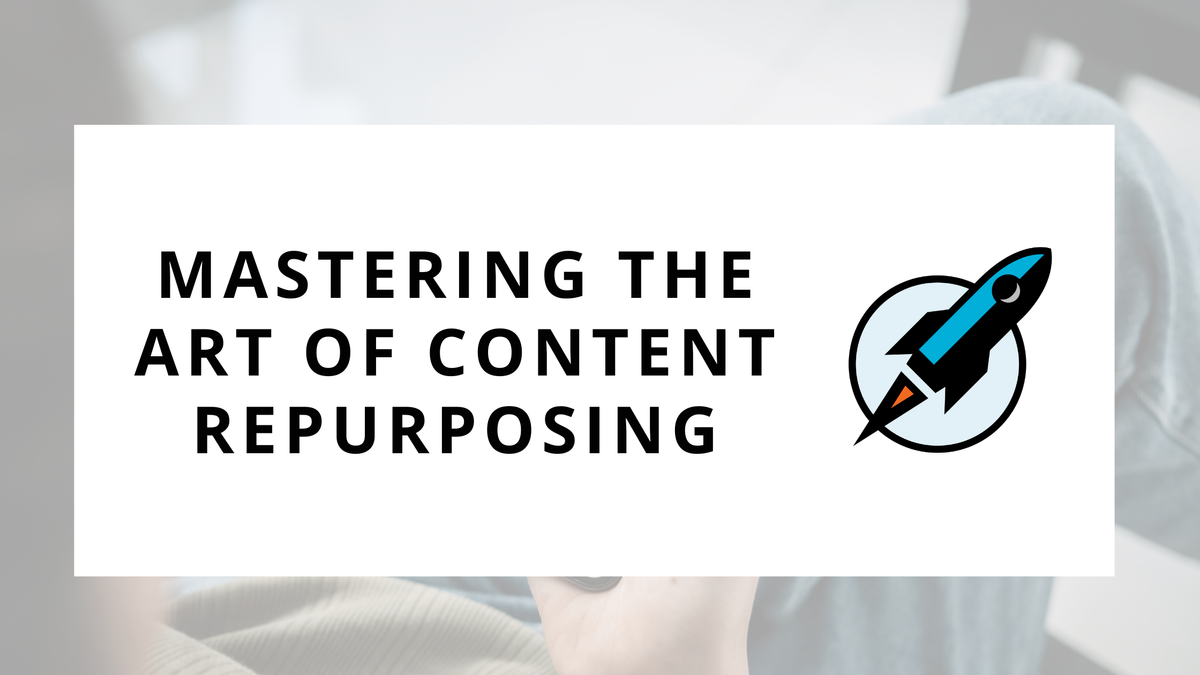Mastering the Art of Content Repurposing

We already know that content is king.
But we also know that content is hard to make. It takes time to come up with ideas, produce the content, and promote it to our audiences.
Which is why I am a BIG proponent of repurposing your content.
This approach not only saves time and resources, but also ensures your message resonates with a wider audience. I've learned the value of transforming a single concept into multiple forms of content, from a LinkedIn post to a blog, a newsletter, and even a webinar.
In this week’s Sell with Social, we’ll explore how you can be strategic with your approach to repurposing content. We’ll discuss what repurposing is, its benefits, and an example of how I’ve repurposed a piece of content in our business.
Repurposing Content 101
Let’s first understand what repurposing content is.
Repurposing content refers to the practice of taking existing content and adapting it for different formats or platforms to extend its reach and lifespan.
This strategy involves reimagining and reformatting a single piece of content to suit various audiences and mediums, rather than creating entirely new content from scratch for each channel.
The process of repurposing content can involve a range of activities. For example, a detailed blog post can be condensed into a series of social media posts, transformed into an infographic, or expanded into a webinar or video.
The core idea remains the same, but the presentation is altered to fit the specific context and audience of each platform.

My approach is always to start with small effort, low value content channels, then work my way up to high effort, high value channels.
For example, starting with a single social media post. I'll test the waters with a quick post that takes me 10-15 minutes to create.
From there, I can build upon the idea in a higher effort piece of content, like a blog post. Creating graphics and more depth to the content. Then, I can turn that into an email newsletter.
Finally, that content can be turned into a live webinar or video piece. This would include thoughts on the way people can interact with the content and engage in a two-way conversation.
The process is simply taking one idea and adding more depth at each stage I repurpose it.
The Benefits of Repurposing
It goes without saying, but there are some obvious benefits to incorporating repurposed content as part of your social selling strategy. These include:
Saves Time - The most immediate benefit of repurposing content is that it saves you time. While you still need to adapt content for each medium/channel, you can reuse the underlying message, ideas, and frameworks across all of them.
Expands Reach - You’ll be able to reach more people, more consistently, by repurposing your content across different channels. We all have various preferences for the way we consume content, and this strategy allows you to meet people in their preferred channels.
Reinforces Ideas: Most people don’t remember your content the first time they view it. By repurposing and resharing your content across multiple channels, you can reinforce the ideas and messaging that you are trying to convey. The more times they see your content, the more likely they are to remember it.
Case Study: The Digital Sales Funnel
Let’s take a look at a recent content piece that I’ve been repurposing across various mediums.
Say hello to the Digital Sales Funnel.
This is the framework that I teach to help teams implement digital sales strategies. It’s a simple idea, which makes it a great example of how I can repurpose it across different platforms.
So let’s walk through how I’ve repurposed the idea across various content types.
Starting with a Social Media Post
A social media post is a great place to start content ideas. It’s quick, easy, and you get instant feedback on the content itself.

In this case, I created a LinkedIn post that breaks down my digital sales funnel. I highlight the Educate > Connect > Consult steps and give a brief overview of each stage.
This social media post also provided me with valuable insights via the engagement I received from it. Who liked it, who commented on it, and what they said.
The goal at this stage of repurposed content is to make your idea “bite-sized” to see if it passes the interest test with your audience.
Expanding into a Blog Post
The next stage in my repurposing is to take a short-form social post and expand it to a full-length blog post. This allows me to take a deep dive into the idea and offer additional insights.
In the Digital Sales Funnel example, I created a blog post that broke down the stages of the digital sales funnel in more detail. In this post, I had room to provide the Why, How, and What of the concept.
While it took significantly more time (about 2-3 hours), the expanded content format allowed me to do some critical enhancements:
- Elaborate on the Main Idea: It allowed me to start expanding on the idea of the original LinkedIn post. I could provide more background, context, and details to give my readers a fuller understanding of the digital sales funnel.
- Incorporate Additional Research and Data: The blog post included relevant research, statistics, and data that supports the main idea. This not only adds credibility to the idea but also provides more value to my readers.
- Add Visuals and Formatting Elements: Unlike a social media post, a blog allows you to use multiple images, infographics, videos, and other multimedia elements. This allowed me to include images, bulleted lists, and bolded text to help make the content more visually appealing to consume.
- Optimize for SEO: The blog also allowed me to use relevant keywords, meta descriptions, and tags to optimize the content for search engines. This helps me tap into search traffic, reaching a wider audience beyond my existing social media followers.
Sending in a Newsletter
The blog post I created was also sent out in my weekly newsletter.

This was an incredibly easy next step, as all I had to do was load the content into an email platform and schedule a send with my subscriber list.
But the big benefit here is yet ANOTHER distribution channel (we’ve already covered social and search engines), by tapping into my email list.
Hosting a Webinar or Live Event
And of course, your content doesn’t need to stay “static” in an asynchronous channel. In the case of the Digital Sales Funnel, I then turned the idea into a webinar.

This is one of my favorite ways to repurpose content. Making it a live event really ramps up the value, engagement, and subsequent sales conversion you can receive from the content.
Those in your audience who have already seen your blog posts or social posts on the topic have already been teased with the ideas. Turning a blog post into a webinar is an excellent way to further engage with your audience and provide an interactive and more personal experience.
Here are some ways to transform a blog post into a successful webinar:
- Turn Blog into Agenda: Develop a detailed outline for your webinar based on the blog post. This should include an introduction, the main body where you delve into each key point, and a conclusion. Remember to leave room for Q&A sessions and interactive elements
- Add MORE Visuals: Design a slide deck to accompany your webinar. These slides can include key points, graphics, charts, and images that complement what you’re discussing. Visual aids can make the webinar more engaging and help illustrate complex ideas.
- Incorporate Q&A and Discussions: Webinars offer a great opportunity for real-time interaction with your audience. Plan interactive elements like polls, Q&A sessions, or live demonstrations. These can make the webinar more engaging and provide valuable feedback.
- Conversion Events: Utilize the webinar to create conversion events from your audience. Beyond the webinar registration itself, downloadable guides, resources, or direct calls to action in the slides can increase the leads you generate.
- Record for Later Viewing: Be sure to also record the live presentation you do. This can be great content to upload to a YouTube channel or share as an ongoing resource on your company website.
The Repurposing Never Stops
You may be asking yourself, “When does the repurposing stop?”
My answer - NEVER.
You can always be recycling content, updating visuals, and building upon ideas. Snippets of a webinar recording can become social posts. Your blog can become a multi-part series, or even a downloadable PDF.
Don’t ever be afraid of repeating the same idea too many times. By the time you are getting bored of your idea, your audience is likely just starting to remember it.
In my example of my Digital Sales Funnel, this is a framework that I’ve been using for seven years! Are you sick of me talking about it yet? My guess is you are not.
Five Tips for Effective Content Repurposing
As a wrap-up to the topic of repurposing, I want to give you a few tips to keep in mind.
Repurposing content isn't just about spreading the same message across different platforms; it's about strategically adapting your content to resonate with various audiences while maintaining its core essence.
Here are some tips to help you do just that:
- Understand Each Platform's Unique Features: Every platform has its strengths and audience preferences. LinkedIn favors professional and career-oriented content, Instagram thrives on visuals, while blogs and newsletters allow for more in-depth exploration of topics. Tailor your content to leverage these unique features.
- Maintain a Consistent Core Message: While the presentation of your content should vary across platforms, the central idea should remain consistent. This consistency reinforces your message and strengthens your brand identity.
- Reformat for Different Mediums: Transform your idea into different formats. A successful LinkedIn post can become an informative blog, a detailed newsletter, and an engaging webinar script. Think about how the format can add new dimensions to your original idea.
- Update and Refresh Content: When repurposing content, it’s essential to update statistics, examples, or references to ensure relevance. This refresh can also involve adding new insights or perspectives that have emerged since the original piece was created.
- Engage with Your Audience: Encourage feedback and interaction across platforms. This engagement can provide valuable insights into how your content is being received and what your audience is most interested in, guiding your future content creation.

For this week’s action items, I want you to start being strategic with how you are repurposing content and ideas in your business.
Begin to reap the benefits of saved time, expanded reach, and reinforced learning that come with repurposing those awesome content ideas you have!
Here is what you can do this week:
- Identify an Evergreen Content Idea - Review your content and look for an idea or resource that has “evergreen” potential; meaning, it's a timeless piece of content. It doesn’t matter what type of content it is now (social post, video, blog, etc.).
- Repurpose the Content - Next, take that piece of content and repurpose it into a new channel. Find ways to refresh, add depth, or make the content more interactive than currently is.
- Share the Content - Finally, share the repurposed content with your audience! Give them a fresh look at an idea they may have started to learn about in the past.
If there is one big takeaway I want to share with you, it’s that repurposing content is not only okay to do, it’s a great strategy to embrace!
